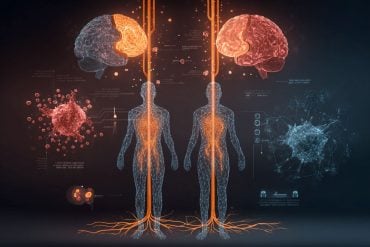Summary: Joint attention, where a person’s attention is drawn to an object someone else is looking at, is fundamental to typical language acquisition.
However, a comprehensive meta-analysis of 71 studies suggests that individuals with autism might learn language differently. The traditional belief is that promoting joint attention would improve verbal expression in those with autism.
This study, however, challenges this view and underscores the importance of exploring diverse methods for teaching language to those with autism.
Key Facts:
- The research, evaluating studies from 1994 onward, found little evidence linking joint attention stimulation to significant language gains in individuals with autism.
- Despite many autistic children developing verbal skills, they often exhibit low joint attention – a trait considered foundational for language acquisition in neurotypical individuals.
- Some children with autism might be more attuned to learning language through written content rather than social interaction, suggesting potential alternative approaches to language education.
Source: University of Montreal
You’re looking at a truck. You’re with a young child and he follows your gaze. He’s interested in the object you’re looking at without you pointing at it. This is called joint attention and it is one of the primary ways children learn to connect words with objects and acquire language.
Lack of joint attention is a core feature of autism. Until now, it was thought that stimulating joint attention in people with autism would help them express themselves verbally. But a meta-analysis of 71 studies on autism challenges this assumption and suggests that people with autism spectrum disorders may acquire language differently.
The study – by Laurent Mottron, a professor in the Department of Psychiatry and Addiction at Université de Montréal and a psychiatrist at the Hôpital en santé mentale Rivière-des-Prairies of the CIUSSS du Nord-de-l’Île-de-Montréal; Mikhail Kissine, a professor of linguistics at Université Libre de Bruxelles; and Ariane St-Denis, a medical student at McGill University – is published in Neuroscience & Biobehavioral Reviews.
The authors looked at all studies of joint attention and language in children with autism since 1994.
They then selected all those that reported a clear measure of structural language using metrics such as vocabulary size, and excluded those that measured only communication skills.
In neurotypical individuals, social interaction plays an essential role in language development. “It makes sense to assume, therefore, that the ability to establish a shared attentional frame may increase the opportunities for autistic children to attend to linguistic stimuli and engage in communicative experiences,” the authors of the study write.
However, their meta-analysis did not find significant language gains from interventions aimed at promoting social communication in people with autism.
“Linking language outcomes to joint attention in autism is somewhat paradoxical, as the significant proportion of autistic children who become verbal still have a diagnosis of autism, a core component of which is, precisely, atypically low joint attention,” they observe. For example, children with Asperger’s develop impressive language skills without developing comparable social skills.
Of the 71 studies, only 28 reported a correlation between stimulation of joint attention in young children with autism and development of simple vocabulary.
“These studies do show that joint attention is associated with a very simple vocabulary of less than five words, but they cannot predict whether the child will be able to express himself correctly at age 7 or 8,” Mottron notes. Twenty-five other studies show no correlation between joint attention and vocabulary development in children with autism.
It is possible that people with autism learn language differently, without social interaction, he adds. “For example, in immigrant populations whose native language is not English, children with autism learn English by looking at digital tablets and never learn to speak their parents’ language.”
If some children with autism are less sensitive to the human voice than to the written word, this could open up new avenues for intervention, Mottron says. “In this case, we should redirect autistic children towards exposure to non-communicative language, in addition to talking to them.”
The study therefore opens the door to new ways of addressing neurodiversity.
About this Autism and language research news
Author: Jeff Heinrich
Source: University of Montreal
Contact: Jeff Heinrich – University of Montreal
Image: The image is credited to Neuroscience News
Original Research: Open access.
“Language acquisition can be truly atypical in autism: Beyond joint attention” by Laurent Mottron et al. Neuroscience and Behavioral Reviews
Abstract
Language acquisition can be truly atypical in autism: Beyond joint attention
Language profiles in autism are variable and atypical, with frequent speech onset delays, but also, in some cases, unusually steep growth of structural language skills.
Joint attention is often seen as a major predictor of language in autism, even though low joint attention is a core characteristic of autism, independent of language levels.
In this systematic review of 71 studies, we ask whether, in autism, joint attention predicts advanced or only early language skills, and whether it may be independent of language outcomes.
We consider only conservative estimates, and flag studies that include heterogenous samples or no control for non-verbal cognition. Our review suggests that joint attention plays a pivotal role for the emergence of language, but is also consistent with the idea that some autistic children may acquire language independently of joint attention skills.
We propose that language in autism should not necessarily be modelled as a quantitative or chronological deviation from typical language development, and outline directions to bring autistic individuals’ atypicality within the focus of scientific inquiry.







